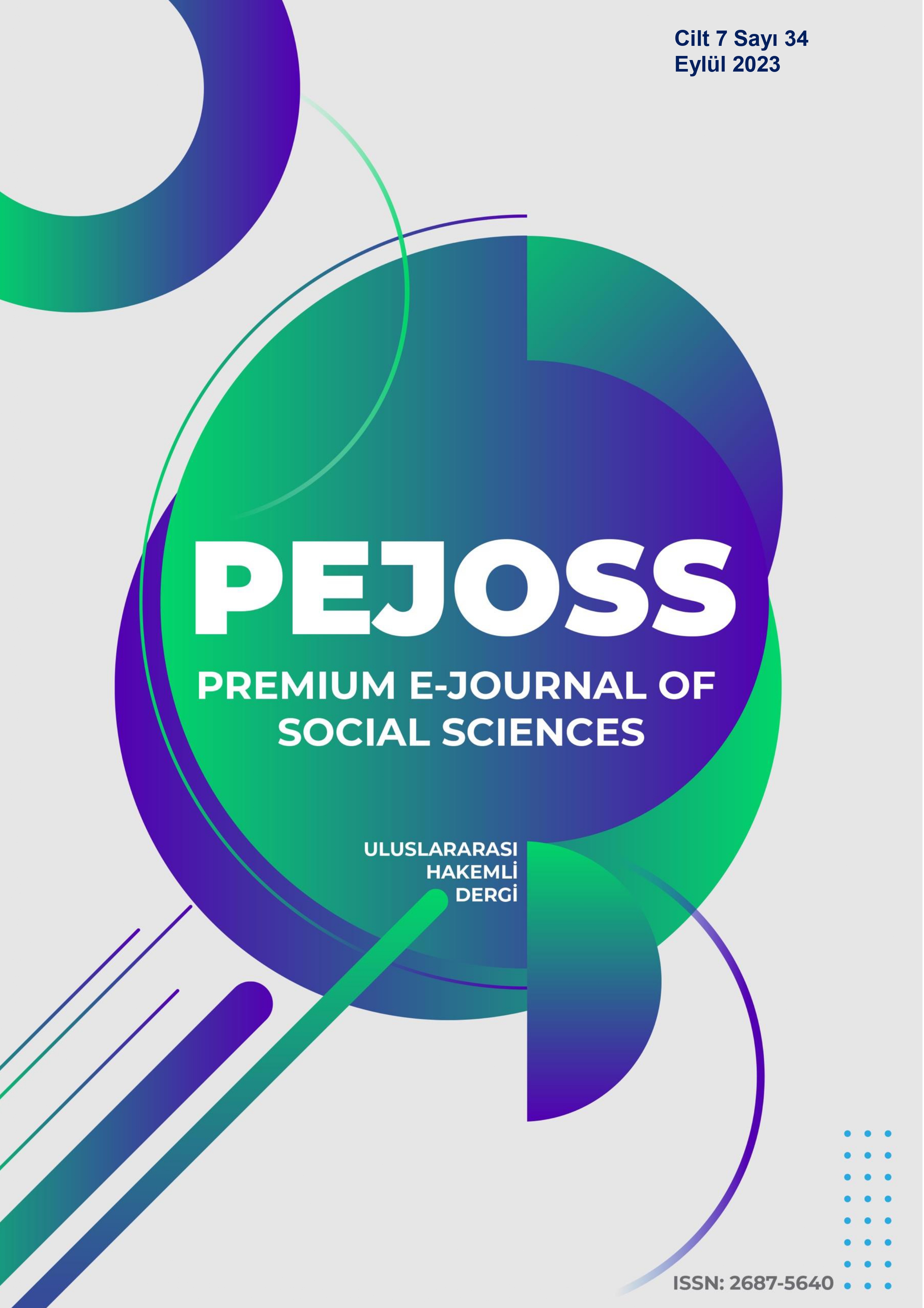The Effect of Defence Expenditure on Economic Growth: Case of Turkey
DOI:
https://doi.org/10.5281/zenodo.8404741Keywords:
Defense Expenditures, Economic Growth, Causality AnalysisAbstract
The aim of this study is to test the causality relationship between defense expenditures and economic growth in Turkey. For this purpose, Johansen Co-integration and Granger Causality Tests were conducted by using the GDP share of defense expenditures, arms imports, arms exports, the ratio of armed forces personnel to the total workforce and Real Gross Domestic Product for the period 1990-2020 of Turkey. According to the test results, two-sided Granger Causality findings were obtained between defense expenditures and arms exports, and between arms exports and gross fixed capital formation, in which defense expenditures and Real Gross Domestic Product variables act together in the long run, there is no Granger causality relationship
Downloads
References
Aktan, C. C. (2007). Bunchanan ve Kamu Tercihi Teorisi. http://www.canaktan.org/ekonomi/ anayasal_iktisat/buchanan-lifelegacy/turkce-kaynaklar/buchanan-kamu-tercihi.htm.
Albayrak, A. S. (2008). Değişen Varyans Durumunda En Küçük Kareler Tekniğinin Alternatifi Ağırlıklı Regresyon Analizi Ve Bir Uygulama. Afyon Kocatepe Üniversitesi, İ.İ.B.F. Dergisi, 10(2), 111-134.
Ateşoğlu, H. S, (2009). Defense Spending and Aggregate Output in the United States. Defence and Peace Economics, 20(1), 21-26.
Batmaz, N. ve Tunca, H. (2007). Türkiye’de Doğrudan Yabancı Sermaye Yatırımlarının Bölgesel Belirleyiciler Üzerine Bir Eş Bütünleşme Analizi (1992-2003), Osmangazi Üniversitesi Sosyal Bilimler Araştırma Dergisi, 1, 199-224.
Bekmez, S. ve Destek, M. (2015). Savunma Harcamalarında Dışlama Etkisinin İncelenmesi; Panel Veri Analizi. Siyaset, Ekonomi ve Yönetim Araştırmaları Dergisi, 3(2), 91-110.
Benoit, E. (1973). Growth Effects of Defence in Developing Countries. International Development Review, 14(1), 2-10.
Başar, S., ve Ünlü, S. (2012). Savunma Harcamalarının İktisadi Büyümeye Etkisi. Sosyal Bilimler Enstitüsü Dergisi, 10, 1-30.
Bulutoğlu, K. (1977). Kamu Ekonomisine Giriş. Temat Yayınları.
Büyükakın, T. (2007). Yeni Keynesyen İktisat mı, Yeni Neo-Klasik Sentez mi? Kocaeli Ü. Sosyal Bilimler Enstitüsü Dergisi, 1(13), 22-36.
Canbay, Ş. ve Mercan, D. (2017). Savunma Harcamalarının Ekonomik Büyüme ve Cari İşlemler Dengesine Etkisi: Türkiye Örneği, Journal of Emerging Economies and Policy, 2(2), 86-104
Çabuk, A. ve Balcılar, M. (1998). What Does A Unit Root Mean? The Statistical and Economic Interpretation Of Unit Root Processes With A Survey Of Unit Root Test, Journal of the Faculty of Economics and Administrative Sciences, Cukurova University, Special Issue on Econometrics, 8, 289-332.
Çıkınlar S. (2006). Savunma Harcamaları ve Türkiye’nin Durumu. [Yüksek Lisans Tezi], Süleyman Demirel Üniversitesi Sosyal bilimler Enstitüsü, Isparta.
Değer, O. ve Demir, M. (2015). Reel Efektif Döviz Kuru ve Dış Ticaret Hacmi Arasındaki Nedensellik İlişkisi: Türkiye Örneği. Finans, Politik ve Ekonomik Yorumlar Dergisi, 52(604), 7-21.
Dickey, D. A. ve W. A. Fuller (1981). Distribution Of The Estimators For Autoregressive Time Series With A Unit Root. Journal of the American Statistical Association, 74(366), 427-431.
Dura, Y. C. (2006). Kamu Tercihi Teorisinde Kamusal Etkinlik Problemi, Türk İdare Dergisi, 451, 107-115
Edizdoğan, N. (2008). Kamu Maliyesi. Ekin Yayınları.
Enders, W. (1995). Applied Econometric Time Series,. (1. edt), Wiley.
Esgin, Y. (2010). Savunma Harcamaları ve Ekonomik Gelişme Arasındaki İlişki; Silah İthalatcısı ve İthalatcısı Ülkeler için Panel Veri Yöntemi İle Bir Analiz. [Yüksek Lisan Tezi] Ege Üniversitesi Sosyal Bilimler Entisutüsü.
Fordham, B, O. & Walker,T, C. (2005). Kantian liberalism, regime type, and military resource allocation: do democracies spend less? Int.Stud.Q.49, 141–157.
Gökbunar, R. ve Yanıkkaya, H. (2004). Savunma Harcamalarını Belirleyen Faktörler ve Ekonomik Büyümeye Etkisi. Ankara Üniversitesi SBF dergisi, 59(1), 164-171.
Gümüştaş, E. (2010). Türkiye’de savunma sanayii ve savunma harcamalarının ekonomideki yeri. [Yayınlanmış Yüksek Lisans Tezi]. Niğde Üniversitesi Sosyal Bilimler Enstitüsü.
Jarque, C. M., ve Bera, A. K. (1987). A Test for Normality of Observations and Regression Residuals, International Statistical Review, LV, 163-172.
Karahan-Türk, H. (2007). Türk Savunma Sanayinin Ekonomik Etkileri ve Savunma Harcamaları-
Büyüme İlişkisinin Ekonometrik Modellenmesi, [Yayınlanmamış YL Tezi], Çukurova Üniversitesi Sosyal Bilimleri Enstitüsü, Adana.
Kollias, C., & Makrydakis, S. (2000). A note on the causal relationship between defence spending and
growth in Greece: 1955–93, Defence and Peace Economics, 11:1, 173-184, DOI: 10.1080/10430710008404945
Korkmaz, S. (2015). The Effect Of Military Spending on Economic Growth And Unemployment in Mediterranean Countries. International Journal of Economics and Financial Issues, 5(1), 273-280.
Looney, R. (1994). The Economics of Third World Defense Expenditures. London: Jaı Press, Inc.
Looney, R. (1995). The Economics of Third World Defense Expenditures. London. Jai Press.
Lovrinovic, I., Benazic, M. (2004). A VAR Analysis of Monetary Transmission Mechanism in the European Union, Zagreb International Review of Economics-Business, 7(2), 2742.
Nadaroğlu, N. (1983). Kamu Maliyesi Teorisi. Kan Dağıtımcılık Yayıncılık.
Peacock, A. T. and Wiseman, J. (1961). The Growth of Public Expenditure in the United Kingdom, Princeton University Press, Princeton.
Poole, E., ve Bernad, J. (1992). Defence Innovation Stock And Total Factor Produvtivity. The Canadian Journal Of Economics. 25(2),440.
Schmindt, M. G. (2001). Demokrasi Kuramına Giriş (M. Emin Köktaş), Çeviren, Vadi Yayınları.
Selen, U. ve Eryiğit, K. (2009). Yapısal Kırılmaların Varlığında, Wagner Kanunu Türkiye İçin Geçerli mi? Maliye Dergisi. Sayı 156.
Sen, S., ve Değer, S. (1995). Mlilitary Expenditure and Developing Countries, T Sandler ve K Hartley İçinde. Handbook Of Defense Economics 1. (s.275-307) Amsterdam: Elsevier Science.
SIPRI. (2006, 2019, 2010). SIPRI Military Expenditure Database, www.sipri.org/databases/milex.
Şenesen, G. (2002). Türkiye’de Savunma Harcamaları ve Ekonomik Etkileri 1980-2001. TESEV Yayınları.
Tarı, R. (2006). Ekonometri (4. Baskı), Avcı Ofset.
Tarı, R. (2010). Ekonometri. (6. Basım), Umuttepe Yayınları.
Tokmakçıoğlu, K. ve Özçelebi, O. (2018). Yapısal Var Modeli Çerçevesinde Kısa Ve Uzun Vadeli Faiz Oranları İle Reel Döviz Kuru Arasındaki Etkileşim. Ege Stratejik Araştırmalar Dergisi, 9 (1), 1-16. DOI: 10.18354/esam.340725
Uzun,T. (2008). Kamu Yararında Değişim: Kamu Tercihi Yaklaşımı Bağlamında Bir Değerlendirme, İçinde: Kamu Yönetiminde Çağdaş Yaklaşımlar, (Editörler: Asım Balcı, Ahmet Nohutçu, Namık Kemal Öztürk, Bayram Coşkun), Seçkin Yayıncılık.
Yılancı, V., ve Özcan, B. (2010). Yapısal kırılmalar altında Türkiye için savunma harcamaları ile GSMH arasındaki ilişkinin analizi. Cumhuriyet Üniversitesi İktisadi ve İdari Bilimler Dergisi, 11(1), 21-33.
Zengin, R. (2010). Savunma Sanayisinin Gelişimi ve Türkiye'de Savunma Harcamalarının Ekonomik Etkileri. [Yüksek Lisans Tezi] Isparta Süleyman Demirer Üniversitesi Sosyal Bilimler Enstitüsü.
Downloads
Published
How to Cite
Issue
Section
License
Copyright (c) 2023 Premium e-Journal of Social Science (PEJOSS)

This work is licensed under a Creative Commons Attribution 4.0 International License.


